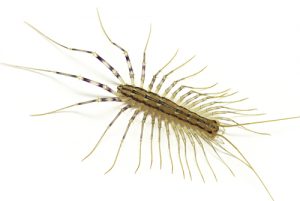House Centipedes, Friend or Foe?
By Chris Williams on January 12, 2012.
Q. I recently sighted a strange, many legged creature scuttling around my kitchen floor. It was about 2 inches long and quickly hid when I moved. What the heck could that be and should I be worried?
A. It sounds like you have sighted the House Centipede. House centipedes originated in Mexico and have spread throughout North America. They live outdoors and in homes. Outside they thrive in damp areas like leaf litter, under boards, and other similar harborage sites. In homes they live in damp areas like basements and wall voids. They are able to pass through very small openings and cracks in search of prey. House centipedes feed on many species of small arthropods and serve as predators in their environment. Hunting mostly at night, they run quickly holding their body up with their long legs.
 As they run they may suddenly stop, remain perfectly still, then just as fast, dart into a hiding place. House centipedes look creepy, up to 3 inches long with 15 pairs of legs, and long antennae in front. The last pair of legs may be twice the length of the entire body making house centipedes appear even larger than they are. Located at the front of the body, are the maxillipeds or toxicognaths. These hardened, pointed appendages are strong and contain ducts that lead to venom glands. These fanglike structures are used to kill prey. Once the prey dies, mouth parts located below the maxillipeds are used to devour the meal. The bodies are grayish-yellow with 3 stripes along the back, the legs are also banded with white. House centipedes are the only centipedes with compound eyes, used in combination with sensitive antennae and hairs for hunting. As they can sense vibrations, movement may startle them and cause them to scurry out of sight. Most commonly sighted in basements, they have been found throughout homes searching for prey. House centipedes are able to reproduce within a structure, and may become quite numerous if adequate food sources are available. Large numbers of house centipedes may indicate other pest populations.
As they run they may suddenly stop, remain perfectly still, then just as fast, dart into a hiding place. House centipedes look creepy, up to 3 inches long with 15 pairs of legs, and long antennae in front. The last pair of legs may be twice the length of the entire body making house centipedes appear even larger than they are. Located at the front of the body, are the maxillipeds or toxicognaths. These hardened, pointed appendages are strong and contain ducts that lead to venom glands. These fanglike structures are used to kill prey. Once the prey dies, mouth parts located below the maxillipeds are used to devour the meal. The bodies are grayish-yellow with 3 stripes along the back, the legs are also banded with white. House centipedes are the only centipedes with compound eyes, used in combination with sensitive antennae and hairs for hunting. As they can sense vibrations, movement may startle them and cause them to scurry out of sight. Most commonly sighted in basements, they have been found throughout homes searching for prey. House centipedes are able to reproduce within a structure, and may become quite numerous if adequate food sources are available. Large numbers of house centipedes may indicate other pest populations.
The life cycle of house centipedes is somewhat complex. Once the egg hatches the larvae have 4 pairs of legs, 5 more larval stages occur each with more legs than the last. Then there are 4 adolescent stages, each with 15 pairs of legs. House centipedes may live for several years. Although house centipedes are venomous, there are very few cases involving injury to man. Most bites are no more painful than a bee sting, but the area should be cleaned to prevent secondary infection. House centipede bites are extremely rare. Control of house centipedes, if needed is not complicated. Due to their many legs and mode of locomotion, house centipedes readily contact common pesticide formulations such as dusts, micro-encapsulated sprays, and wettable powders. They are also extremely sensitive to flushing agents containing pyrethrins. Pest control professionals may also recommend treatment to control prey species within the house, control of moisture within a structure, and sealing gaps and cracks that lead to wall voids or other locations that may harbor house centipedes.